
The Benefits of Pruning
Proper pruning contributes to the long-term health of the tree. Pruning for structure and clearance is the primary way to care for a tree post-establishment. Young tree pruning is the most cost effective thing you can do for an urban forest, but pruning is a process that happens throughout a tree’s life, every few years for the first 30 years. You can manage structural defects, create clearance for vehicles, and develop a resilient form that can coexist with the urban environment and endure storms and other stresses.
Your tree can provide so many benefits to you and your neighborhood—cooling shade, air and water quality, habitat creation, and so much more—and those benefits increase exponentially as the tree grows and ages. And the earlier you properly prune your tree, the greater the chance that it will grow to a ripe old age benefitting your neighborhood and the community forest for generations to come.
Especially in our built environment, pruning a tree is like preventative medicine. Actively taking care of your tree—regular pruning, continued watering, etc.— before issues arise can help it provide its full benefit to you, your neighbors, and your community.
Issues Addressed By Pruning
Some people worry that pruning seems injurious to a tree. Although a pruning cut does result in a wound, trees are more easily able to recover from a proper pruning cut than from improper pruning cuts or a traumatic loss caused by forces of nature such as wind, rain, or even the weight of the tree branch itself. Pruning enables tree stewards to improve the trees’ long-term health and form by addressing the following issues:
1. Dead/Decaying/Damaged
Removal of dead, decaying, and damaged branches helps a tree compartmentalize the affected section and prevent further damage from disease, decay, or pests. It is crucial that those cuts be done outside of the branch collar, leaving a clean wound. Ragged cuts along broken/damaged branches won’t seal as nicely as clean cuts do.
2. Suckers/Epicormic Growth
A “sucker” is growth that develops from a bud at the base of a tree or shrub or from its roots. It is a form of asexual reproduction meant to provide a tree with a means of survival when it is experiencing stress. “Epicormic growth” is produced along the trunk of a tree by buds that lay beneath the bark. Those buds grow when damage occurs at a higher point within the canopy or when light improves as surrounding plants or structures are removed. Both suckers and epicormic growth divert energy from the tree’s canopy and should be removed via proper pruning.
3. Co-Dominant Leaders
Occasionally, we find that trees have developed multiple “co-dominant leaders” or trunks. These are characterized by two (or more) stems of near equal size that arise out of a narrow branch angle. They are examples of poor branch attachment that are prone to breakage due to rain, wind, or even just the weight of the branches themselves.
Co-dominant stems also often lead to incidences of included bark, a condition that typically results in trunk decay due to trapped moisture and organic material.
Most often, one of our goals when performing structural pruning is to establish a single trunk or “central leader.” Pruning away entirely or using a reduction cut to suppress the smaller, less vigorous branch is the best way to re-establish a single central leader. In the long term, this type of reduction could prevent the development of decay or a large branch from snapping off, preventing injury and damage to people, property, and the tree itself.
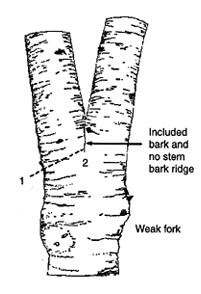

The above illustrations from University of Florida’s horticulture Professor Ed Gilman shows the proper way to address co-dominant leaders characterized by included bark. A cut should be made along the dotted line indicated by the number 1 in the image at left. Keep in mind that it might be both safer and easier to first make a cut several inches out from the junction to remove the bulk of the branch, then make a second cut to remove the last few inches of the branch. This allows the pruner to take better care not to cause unnecessary harm to the remaining central leader.
The second Gilman illustration at right, shows a much less problematic co-dominant leader union. In this case, the branches are spaced well enough for a stem bark ridge to be present, which indicates the overlapping of trunk and branch wood and a union resistant to breakage. It is not necessary to remove a co-dominant stem under these circumstances, although it may still be desirable given other considerations.
Dr. Gilman also released this video about “Aspect Ratio”, the idea being to remove or reduce any branch 50% or larger than the diameter of the trunk itself. If left unpruned, it will potentially grow into a co-dominant leader in the future and be at greater risk of breakage during extreme weather.
4. Raising the Canopy
Another important reason to prune urban street trees is to provide clearance along transportation corridors. In Portland, for example, the Portland Department of Transportation (PBOT) calls for a minimum of 7.5 feet of clearance from limbs to the sidewalk below and 11 feet from limbs to street on a mature enough tree, so our young tree pruning can be done with this goal in mind.

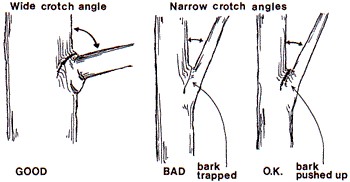
5. Form (Crossing/rubbing/included bark)
Our final consideration as street tree pruners is to leave the tree with a nice form so that it looks tidy and balanced. That can be accomplished in several different ways, including the pruning of crossing or rubbing branches as well as by addressing included bark. Crossing branches are often the result of a branch growing back toward the center of the tree rather than outward toward the edge of the canopy. That and other conditions can cause two branches to rub, which can damage a branch’s bark and ultimately invite disease.
Included bark is the result of too acute an angle forming between the central leader and a lateral branch, characterized by a “V” shape at the junction. Junctions of that type are infamously weak and commonly involved in cases of storm damage, so addressing them as a precautionary measure prevents that breakage and minimizes risk to the tree and surrounding property. More than 80% of structural failures of mature trees are due to included bark.
Branch crotches characterized by a “U” shape should produce a branch bark ridge, an indication that the branch is anchored in the tissue of the tree’s central leader and therefore that the architecture of that junction is strong.
Spacing of lateral branches encourages proper trunk development by helping to balance the canopy, while reducing the wind resistance that can be created by an imbalanced canopy. This becomes more important as a tree ages, but pruners can remove crowded branches to create space as long as they stay within their “pruning budget”—under 25% total canopy removal annually. Radial branch spacing (shown below), for example, increases air circulation within a tree’s canopy and can maximize sun exposure for flowering or fruit ripening.
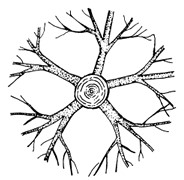
Compartmentalization of Decay in Trees (CODIT)

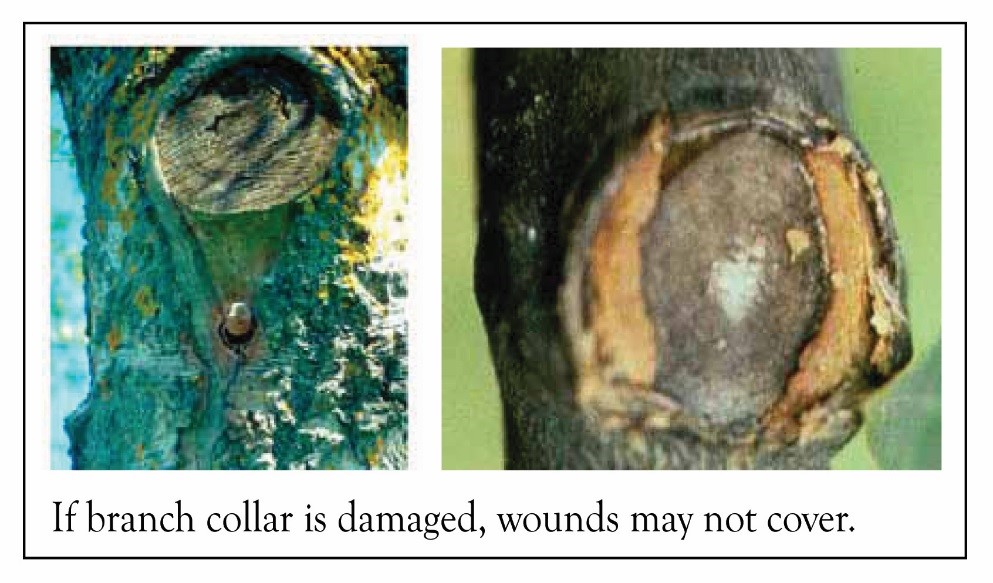
Unlike humans, trees do not have the capacity to heal wounds. Wounds, like those caused by pruning, open the tree to fungal infection and decay. Trees aren’t able to “heal”, but they can “seal” by walling off wounds into compartments. They can block off the damaged area to prevent spread of decay. Any opening (“wound”) made by a proper pruning cut represents the tree’s best chance to quickly close itself off to pests and diseases while also improving the structure, clearance, and durability of the tree in the face of extreme weather. Furthermore, when done on young trees the saying goes that “a five-cent cut today prevents the need for a hundred-dollar cut in years to come.”
In essence, a tree is a series of boxes or compartments framed by annual growth rings and rays. Decay is the primary enemy because it leads to weakness and eventually to breakage. The “branch collar” is where the tree’s sealing hormones reside. When a clean pruning cut is made immediately outside of the branch collar, those hormones are triggered to close the wound and form what resembles a “doughnut” (photo top left). When a jagged cut is made or when the branch collar is damaged, decay is far more likely to result (photo top right).
The Implications of Pruning and the Pruning “Budget”
During photosynthesis in trees, carbon dioxide and water combine in the presence of sunlight to produce oxygen, sugars, and water. Though the oxygen and water are given off, much of the sugar (other than that within its fruits) is stored by the tree for use when necessary. For the most part, that sugar is stored in the roots during the winter and rises through the sap in the spring as the tree begins to produce leaves, flowers, and the fruit of cones (seeds).
The leaves of a tree could be considered to be like solar panels that fuel this process. When we prune, we are removing some of a tree’s ability to photosynthesize, which becomes a problem should we remove too many branches. For that reason, we need to be mindful of how much of the canopy we remove in any given year. In general, the goal should be to remove as little of the canopy as possible to achieve our goal with the maximum amount removed being no more than 25% in any one year.
Given that the sugars are stored in the roots during the winter, pruning when a tree is dormant invigorates growth because the sugars will provide energy to grow new branches once the tree breaks dormancy and sugars rise from the roots. On the other hand, pruning during summer months limits the plant’s ability to store sugar because it hasn’t descended to the roots for winter storage yet. In this way, summer pruning does not encourage growth. (Again, it is important to understand that this does not ultimately limit the size of the tree at maturity because that is genetically predetermined by the species/root stock.)
Tools for Pruning

With regard to the tools, hand pruners and a saw will be almost all you need. “Anvil” pruners work like a knife on a cutting board and are best used only on dead wood. Bypass pruners (pictured) work like scissors and are best to use on live wood. They are generally used for small branches only, about the diameter of a pencil for most people though that depends also on a person’s hand strength. If you find yourself really squeezing a small branch or for any branches up to about 4″ diameter, a folding pruning saw (as shown in the photo) will be your best option. Available but not always necessary are both pole pruners and pole saws, which function about the same as the hand-held versions with extended reach.
Types of Pruning Cuts
There are two primary cuts used to prune a street tree, which are best explained by the following illustration:
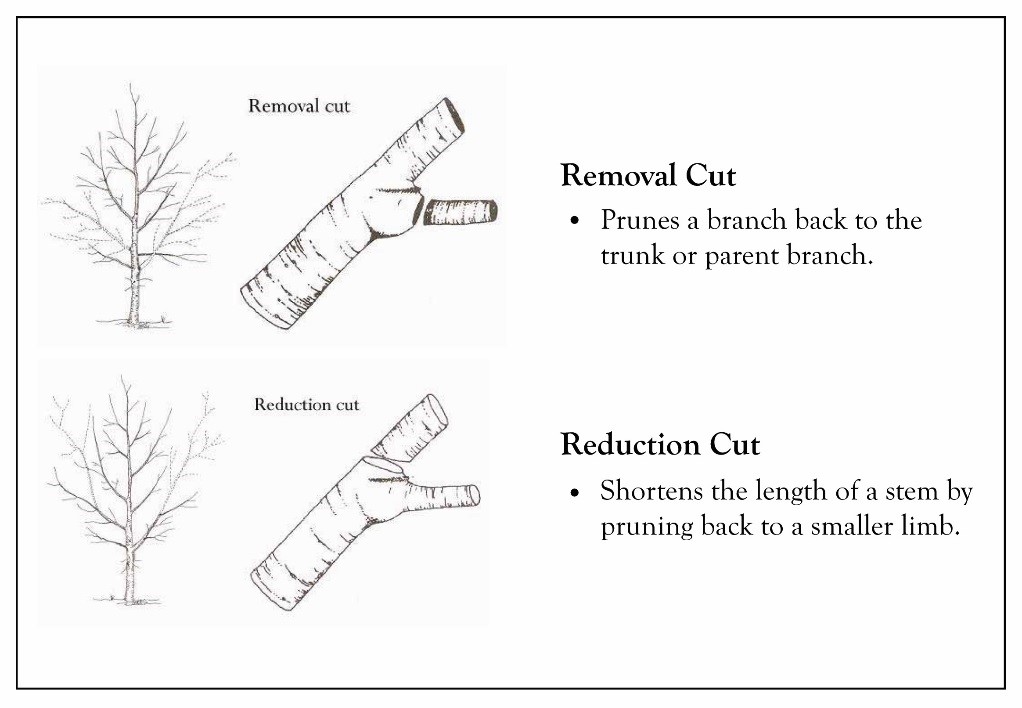
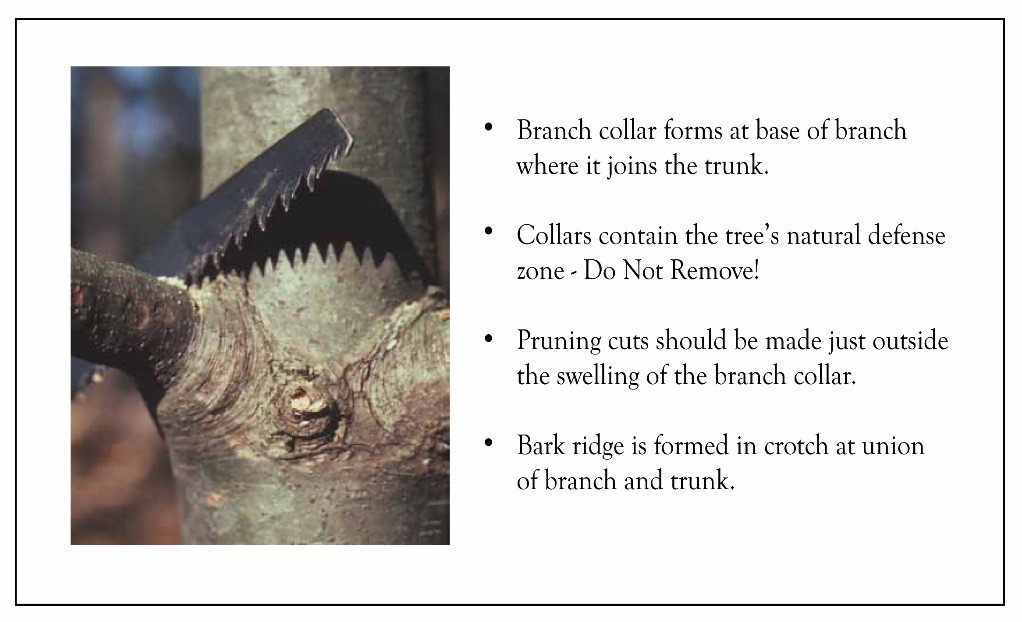
When choosing a lateral limb to be removed, take the branch back to the trunk or parent branch just outside of the branch collar. Do not leave stubs, as they invite decay. Removal cuts are usually the preferred cut.
After identifying the limb to be removed, find the branch collar. This will often look like raised, wrinkled tissue encircling where a branch emerges from the trunk (though is less immediately apparent on some species). The branch collar is very important in that it contains cells which are capable of developing callus tissue to seal over the pruning wound.
Sometimes, we may choose to shorten a limb back to a smaller branch junction. This is called a reduction cut. Reduction cuts generally take longer to seal because there is not a branch collar with sealing hormones to help with recovery. In some cases, the result may be that the tree does not seal itself completely against future pests or decay.
Cuts that remove the branch collar are called “flush cuts” (photo at left below). As previously noted, a tree’s ability to seal over the pruning wound is severely impacted or even entirely eliminated when the branch collar is damaged in this way. PLEASE DO NOT EVER FLUSH CUT!
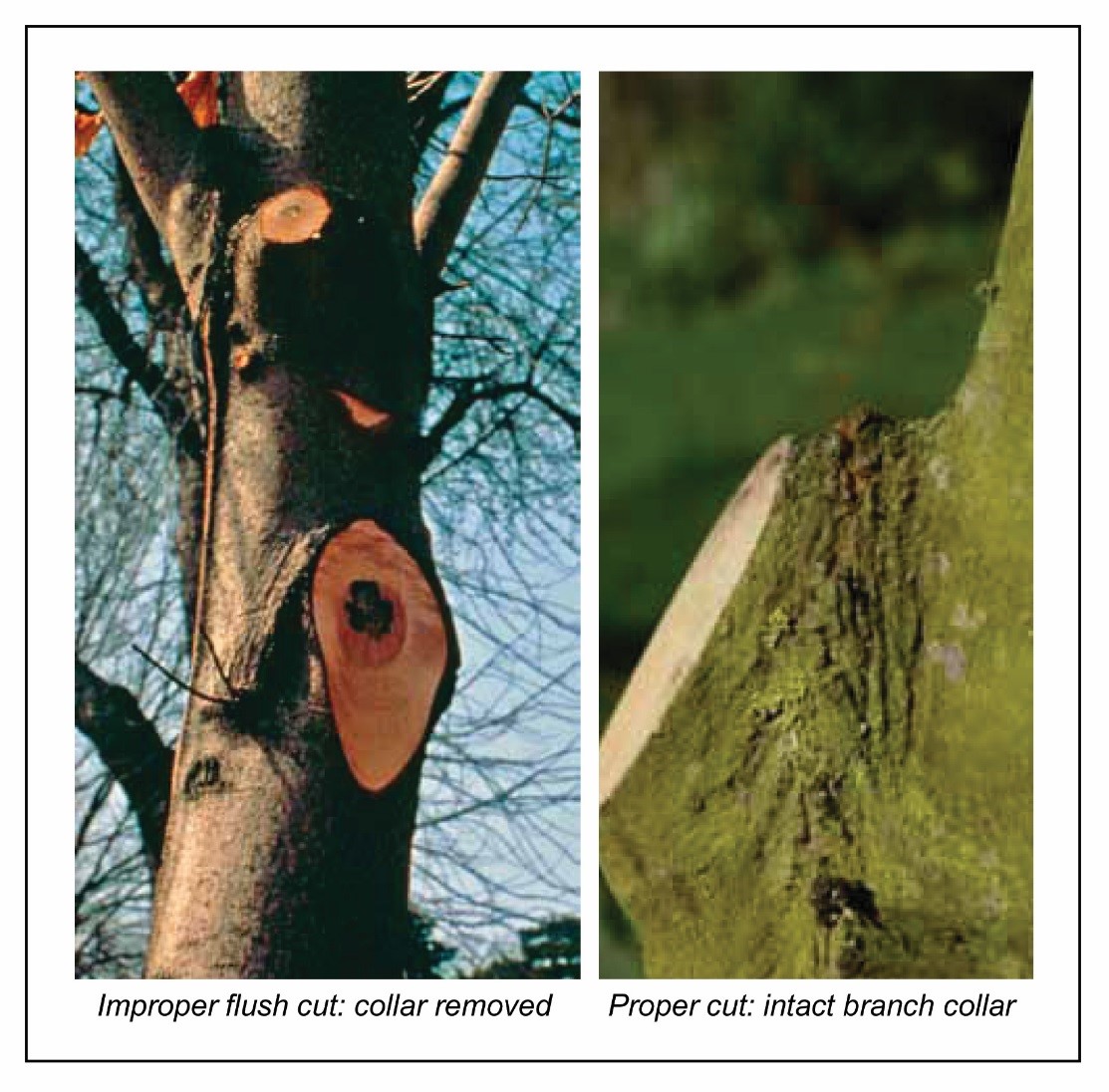
The Three-Cut Method
Always use the three-cut method when using a pruning saw to remove larger limbs. The technique of this method is best illustrated below left.
You can employ a similar weight reduction technique when using hand pruners or loppers just by making your first cut a few inches further out from the branch collar—particularly when addressing included bark.
The primary reason for using the 3-cut method is to remove the weight of a branch from the cut point. If this weight is not removed, a single cut initiated from the top of the branch can lead to a potentially large tear in the bark beneath the branch, unnecessarily opening of the cambium layer to decay (below right).
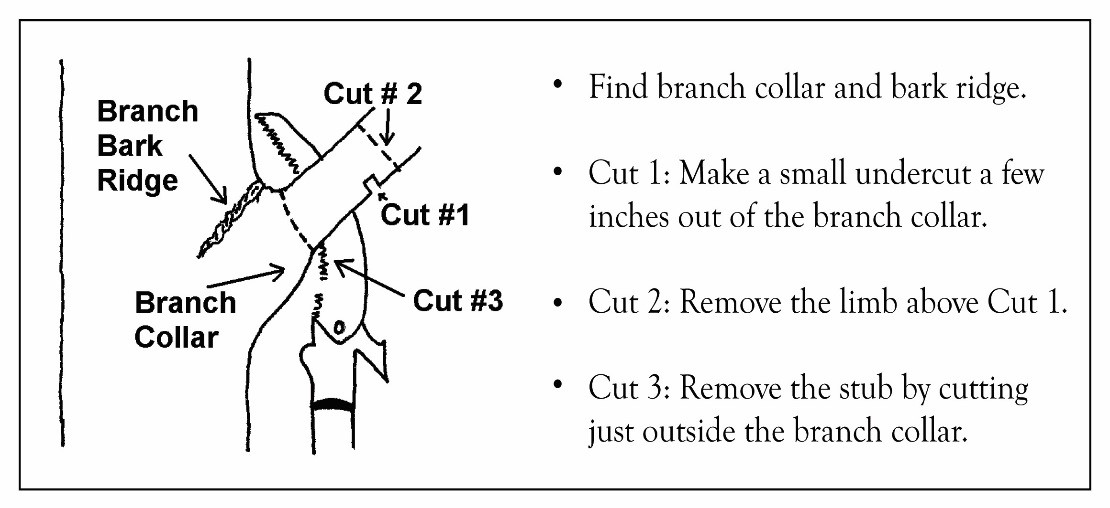
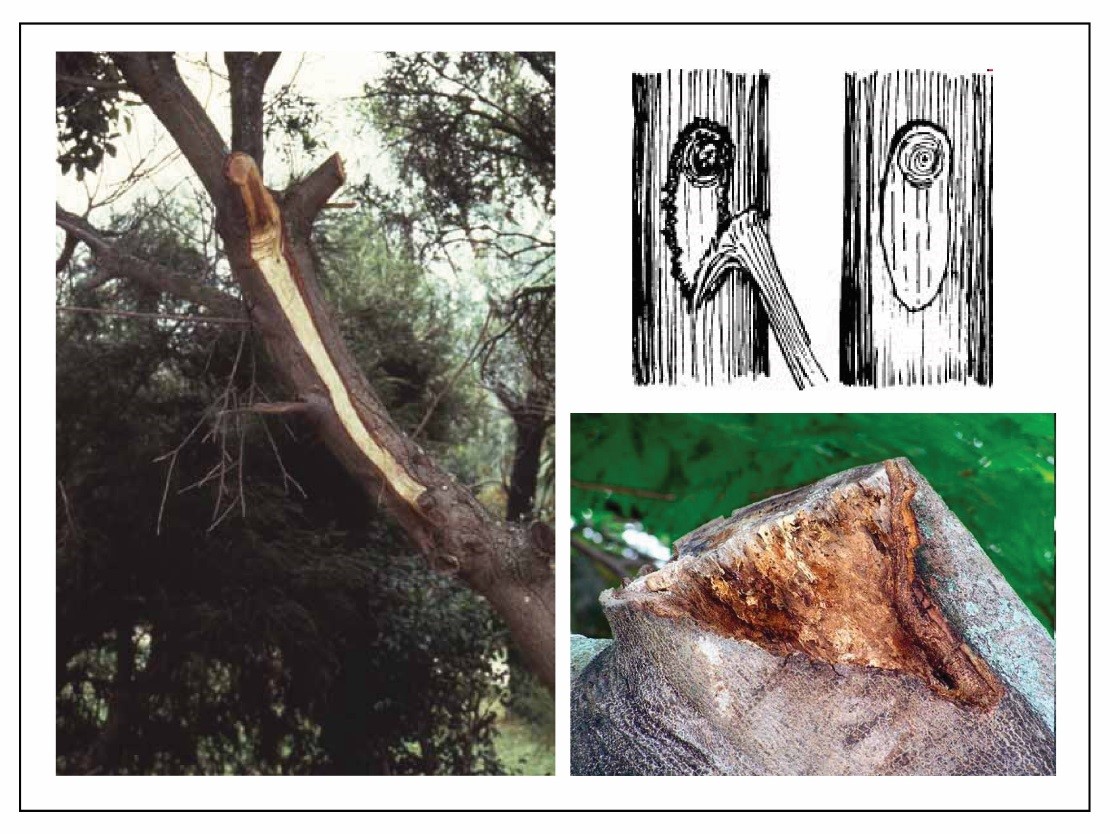
Never “top,” sheer, or hedge trees
Topping trees violates all of the pruning principles that we have talked about. Most people who top trees do so to reduce the size of a tree, but this approach will not work in the long term, as that is dictated by genes or by rootstock when a tree has been grafted. Furthermore, stressed trees are more vulnerable to suckering, insects, and disease infestations. The difference between reduction cuts and topping is that reduction cuts are made just beyond a branch 1/3” the diameter of the parent branch, whereas topping cuts are indiscriminate. Reduction cuts channel energy into the smaller lateral that remains, but topping cuts result in a desperate flush of growth as the tree tries to recover.

Visual of the Process and End Result
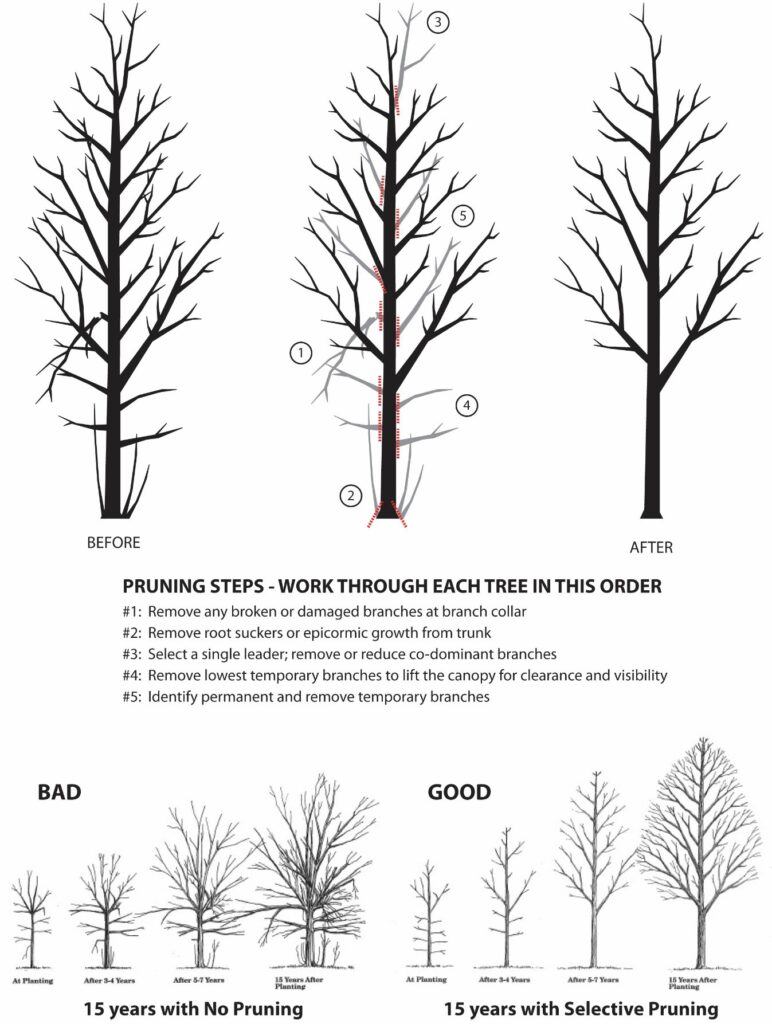
When to Prune and Why Genus Matters
There is a saying, “It’s time to prune whenever the tools are sharp.” That said, depending upon the species and your goals, timing does have a short-term impact on tree growth. Trees must always respond to pruning and how the do can change depending on when the cuts are made.
Prune in the winter to encourage vigorous growth the following spring. Tree stewards will also find that pruning while a deciduous tree is dormant (after the leaves have fallen for the winter) is helpful because it is much easier to see branching at that time of year. Pruning flowering trees such as lindens and crape myrtles just before they break dormancy will enhance flowering because they grow on current year’s wood.
Summer pruning removes some leaves and therefore reduces the tree’s ability to photosynthesize. For that reason, prune in the summer to slightly slow next season’s tree growth. (*Please note that summer pruning will not ultimately reduce the mature height of a tree. That is determined by tree species or root stock for trees that have been grafted.) For flowering trees, prune in the spring after bloom for a good flower set the next season. In our area, July and August are not bad for summer pruning because they are after the initial spring flush of growth, yet allow time for the tree to react with green (“herbaceous”) new growth that has time to harden off (turn into brown wood) before being adversely affected by fall frost.
Some trees tend to drip sap when pruned in the late winter/early spring as sap flows from roots to the canopy. Pruning such trees during the summer can help avoid this issue. Genera that are affected include:
| Betula (Birch)* | Celtis (Hackberry) | Acer (Maple) |
| Ulmus (Elm)** | (Gleditsia) Honey Locust | Liriodendron (Tulip Tree) |
| Cornus (Dogwood) | (Magnolia) Magnolia | Juglans (Walnut) |
*It is recommended not to prune birch trees from late April to mid-July as female bronze birch borers are attracted to fresh cuts.
**Pruning any species or variety of elm between April 15 and October 15 is prohibited within the City of Portland as a means of preventing the potential spread of Dutch Elm Disease.
Furthermore, some species of trees compartmentalize more efficiently or effectively than others. In general, some genera that tend to be strong compartmentalizers are:
| Fagus (Beech) | Carpinus (Hornbeam) |
| Ulmus (Elm) | Platanus (Sycamore) |
| Crataegus (Hawthorn) | Pinus (Pine) |
| Gleditsia (Honey Locust) | Juglans (Walnut) |
Some genera that have proven to be less strong with regard to their ability to compartmentalize are:
| Fraxinus (Ash) | Salix (Willow) |
| Betula (Birch) | Fruit (in general) |
| Aesculus (Horse Chestnut) | Picea (Spruce) |
| Populus (Poplar) | Tsuga (Hemlock) |
Prefer to have a professional prune your tree? Visit our Arborist Partner page.
Thanks for looking out for the health of your tree!

